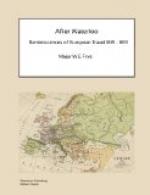The climate of Genoa is said to be exceedingly mild during the winter, being protected on the north by the Appennines, which tower above it to an immense height. Beautiful villas and grounds tastefully laid out in plantations of orange trees, pomegranates, etc., abound in the environs of this city, and everything announces the extreme industry of the inhabitants, for the soil is proverbially barren. This shews what they have done and what they could still do were they free; but now they have nothing to animate their exertions. The public promenades are on the bastions and curtains of the fortifications, on the Esplanade and in the streets Balbi, Nuova and Nuovissima. There is also another very delightful promenade, tho’ not much used by the ladies, viz., on the Mola or Pier enveloping the harbour.
One of the most remarkable constructions in Genoa is the bridge of Carignano, which is built over an immense ravine and unites the hills Fengano and Carignano. It is so high that houses of six stories stand under its arches in the valley below. No water except in times of flood runs under this bridge and it much resembles, tho’ somewhat larger, the bridge at Edinburgh which unites the old and new towns. The principal churches are: first, the Cathedral, which is not far from the Ducal Palace; it is richly ornamented and incrusted with black marble; the church of the Annunziata and that of St Sire. They are all in the Gothic style of architecture and loaded with that variety of ornament and diversity of beautiful marbles which distinguish the churches of Italy from those of any other country. Near the bridge of Carignano is a church of the same name, wherein are four marble colossal statues.
On the west of the city and running two miles along the sea-beach is the faubourg of St Pietro d’Arena, which presents a front of well built houses the whole way; these houses are principally used as magazines and store houses.
FLORENCE, 5 May.
I left Genoa on the 30th April, returned on mule-back from Genoa to Sarzana, stopping the first night at Sestri. The second evening when near Sarzana, it being very dark, I somehow or other got out of the road and my mule fell with me into a very deep ditch; but I was only slightly bruised by the fall; my clothes however were covered with dirt and wet. The road from Genoa to Sarzana might with very little expense be made fit for carriages by widening it. At present it is only a bridle road, and on some parts of it, on the sides of ravines, it is I think a little ticklish to trust entirely to the discretion of one’s monture; at least I thought so and dismounted twice to pass such places on foot. A winding stream is to be forded in two or three places, but it is not deep except after rains; and then I think it must be sometimes dangerous to pass, till the waters run off. Those, who are fond of mountain scenery will, like myself, be highly gratified in making this journey; for it is thro’ the loftiest, wildest and most romantic part of the Appennines. From Sarzana I hired a cabriolet to return to Pisa and from thence I took the diligence to Florence.




